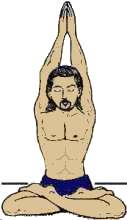Urticaria is a skin disease in which pale red swellings in groups on the surface of the skin are observed mainly on the trunk along with itching. Urticaria is a case of hypersensitivity reaction of the skin to allergens. Urticaria develops around loose tissues of the eyes or lips, the affected area may swell excessively causing pain and discomfort, although scary in appearance, the swelling goes away in 12 to 24 hours with right treatment.
This disease is also known as "Nettle rash"or "Hives" as the rash of urticaria resembles the sting of a nattle. It is also known as "Sheeta pitta" in Ayurveda.
Symptoms of Urticaria :
- Red or white patches on the skin with burning, itching, stinging. The eruption may be as small as pin heads or as large as a rupee.
- Fever, digestive disturbance, prostration.
- The eruption may be rounded or irregular and often surrounded by a reddened zone.
- The disease may affect either part of the whole body.
Causes of Urticaria : (1) Digestive disorders- It may result from digestive disorders like mechanical irritation in the digestive tract or toxemia. (2) Drugs like aspirin, penicillin, quinine. (3) Certain food often cause urticaria in susceptible individuals. These include strawberries, tomatoes, cucumber, oatmeal, wheat, nuts, fish, eggs, chocolate, cheeze, butter. (4) Bites of bedbugs, wasps, bees, mosquitoes, flies. (5) Emotional excitement. (6) Viral infection. (7) Vaccines and blood transfusions. (8) Synthetic products such as deodorant, perfume and talcum powder, cosmetic products, animal derivatives, and similar synthetic substances may cause Urticaria.
Types of Urticaria :
- Acute Urticaria : It last for 6 weeks or less.
- Chronic Urticaria : It last more than 6 weeks.
Home remedies for Urticaria :
- Salt : About 12 grams of salt should be dissolved in water and taken by patient. The throat should be tickled to induce vomiting. This will help in curing eruption.
- Rose water and vinegar : When there is a severe itching on the eruption, abut 35 ml rose water mix with 25 ml of vinegar and applied locally to the affected area. This will give immediate relief.
- Mint : 7 gm of mint and 25 gm of brown sugar should be boiled together in about 175 ml of water and drunk. This will relieve the itching.
- Turmeric : Patient should take 2 tsp of turmeric powder mixed with a cup of water daily.
- Rauwolfia : 1 gm of powdered root can be taken with a cup of water daily.
- 3 gm of root powder of Arni should be taken with 12 gm of pure ghee twice daily.
- For local application, prepare a paste from turmeric, seeds of chakramarda and sesame, kooth and massage over the affected portions. Once or twice a day.
- Application of calamine lotion is workable up to certain extend in Urticaria.
- Take a tub, filled 1/2 with luke warm water and add 1/2 cup of cornstarch with 1/2 cup of backing soda. A person suffering from urticaria will have to soak the body in to this at least once a day.
- Use the pulp of Aloe or a cream containing Aloe on the affected area.
- One can have nattle tea. Add honey or lemon for flavor. Nattle are considered having property to heal urticaria.
Other treatment for Urticaria :
- Warm water enema.
- Exposure to fresh air and sunlight.
- Avoid exposure to cold and cold water.
- Hot epsom salts bath : This bath is prepared by dissolving 1 kg of commercial epsom salts in an ordinary bath of hot water,taken three times a week, at least for 10-20 min.
Diet for Urticaria :
- All fruits diet : The patient should take three meals a day of fresh juicy fruits such as oranges, apples, pineapples, grapes, pears, peaches, papayas.
- Well balanced food consisting of nuts, seeds, grains, vegetables and fruits. The emphasis should be on fresh fruits and raw vegetables salads.
- Avoid tea, coffee, alcohol, all fresh foods, refined food which are difficult to digest.
- Water and lemon intake : A glass of water containing the juice of half a lemon may be taken one hour before each meal and also between meals.
Raktmokshan (blood-letting) : Raktmokshan is an Ayurveda method used to draw out a certain amount of toxic blood from the body. This helps in detoxifying the blood, thus helping mainly in various chronic skin disease. Often leech is used to suck out the impure blood from the affected area.
Ayurvedic medicines :
- Haridra khanda - thrice daily with water
- Rasa sindur - thrice daily with water
- Gairic (Red ochre) - 5 grains, thrice daily with water/ honey
- Arogyavardhini rasa - thrice daily with honey
- Sut shekhar rasa - thrice daily with honey
- Urtiplex (charak) - 1 tab, 3-4 times a day
- Kaishore guggulu - 2 tab, twice daily
- Khadirarishta - 3 tsp, twice daily







